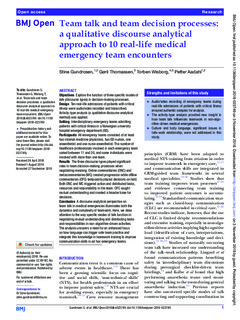| dc.contributor.author | Gundrosen, Stine | |
| dc.contributor.author | Thomassen, Gøril | |
| dc.contributor.author | Wisborg, Torben | |
| dc.contributor.author | Aadahl, Petter | |
| dc.date.accessioned | 2019-02-11T09:42:28Z | |
| dc.date.available | 2019-02-11T09:42:28Z | |
| dc.date.created | 2018-11-03T16:49:24Z | |
| dc.date.issued | 2018 | |
| dc.identifier.citation | BMJ Open. 2018, 8 (11), . | nb_NO |
| dc.identifier.issn | 2044-6055 | |
| dc.identifier.uri | http://hdl.handle.net/11250/2584722 | |
| dc.description.abstract | Objectives Explore the function of three specific modes of talk (discourse types) in decision-making processes.
Design Ten real-life admissions of patients with critical illness were audio/video recorded and transcribed. Activity-type analysis (a qualitative discourse analytical method) was applied.
Setting Interdisciplinary emergency teams admitting patients with critical illness in a Norwegian university hospital emergency department (ED).
Participants All emergency teams consisted of at least two internal medicine physicians, two ED nurses, one anaesthetist and one nurse anaesthetist. The number of healthcare professionals involved in each emergency team varied between 11 and 20, and some individuals were involved with more than one team.
Results The three discourse types played significant roles in team decision-making processes when negotiating meaning. Online commentaries (ONC) and metacommentaries (MC) created progression while offline commentaries (OFC) temporarily placed decisions on hold. Both ONC and MC triggered action and distributed tasks, resources and responsibility in the team. OFC sought mutual understanding and created a broader base for decisions.
Conclusion A discourse analytical perspective on team talk in medical emergencies illuminates both the dynamics and complexity of teamwork. Here, we draw attention to the way specific modes of talk function in negotiating mutual understanding and distributing tasks and responsibilities in non-algorithm-driven activities. The analysis uncovers a need for an enhanced focus on how language can trigger safe team practice and integrate this knowledge in teamwork training to improve communication skills in ad hoc emergency teams. | nb_NO |
| dc.language.iso | eng | nb_NO |
| dc.publisher | BMJ Publishing Group | nb_NO |
| dc.relation.uri | https://bmjopen.bmj.com/content/8/11/e023749 | |
| dc.rights | Navngivelse-Ikkekommersiell 4.0 Internasjonal | * |
| dc.rights.uri | http://creativecommons.org/licenses/by-nc/4.0/deed.no | * |
| dc.title | Team talk and team decision processes: a qualitative discourse analytical approach to 10 real-life medical emergency team encounters | nb_NO |
| dc.title.alternative | Team talk and team decision processes: a qualitative discourse analytical approach to 10 real-life medical emergency team encounters | nb_NO |
| dc.type | Journal article | nb_NO |
| dc.type | Peer reviewed | nb_NO |
| dc.description.version | publishedVersion | nb_NO |
| dc.source.pagenumber | 8 | nb_NO |
| dc.source.volume | 8 | nb_NO |
| dc.source.journal | BMJ Open | nb_NO |
| dc.source.issue | 11 | nb_NO |
| dc.identifier.doi | 10.1136/bmjopen-2018-023749 | |
| dc.identifier.cristin | 1626619 | |
| dc.description.localcode | © Author(s) (or their employer(s)) 2018. Re-use permitted under CC BY-NC. No commercial re-use. See rights and permissions. Published by BMJ. | nb_NO |
| cristin.unitcode | 194,65,25,0 | |
| cristin.unitcode | 194,62,60,0 | |
| cristin.unitname | Institutt for sirkulasjon og bildediagnostikk | |
| cristin.unitname | Institutt for språk og litteratur | |
| cristin.ispublished | true | |
| cristin.fulltext | original | |
| cristin.qualitycode | 1 | |

